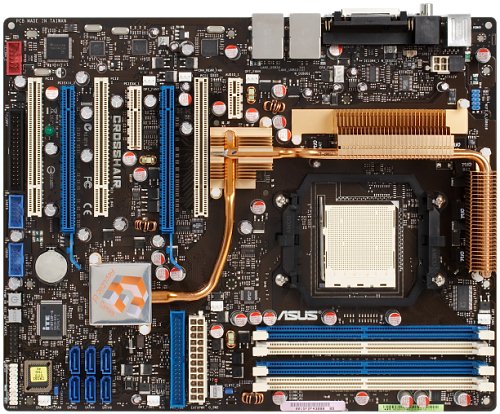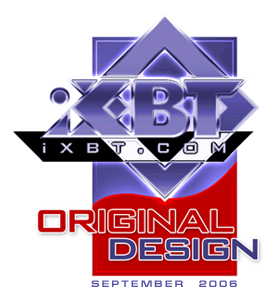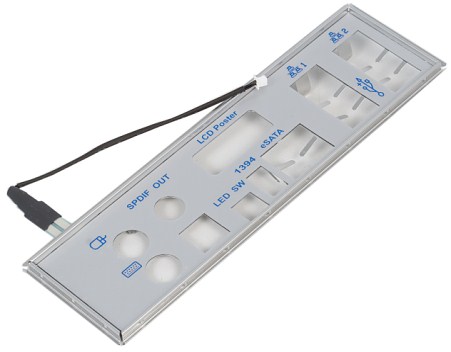 |
||
|
||
| ||
Along with inexpensive mainstream and reasonably expensive models, the leading motherboard manufacturers indulge in producing elite models as well. Their sales hardly amount to 500-1000 items (depending on sales and elite properties of the product itself) for the entire life cycle of such a "monster". But such motherboards do their ad/demo job well. Designing them pays off by attracting users' attention to the brand and… less expensive motherboards, which in time absorb the initially-ultimate options.
In order to stress the unique nature of the flagship model based on the nForce 590 SLI chipset, ASUS masterpiece has a proper name instead of a usual alphanumeric designation. The name has a gaming undertone. The term "Crosshair" means crosses and circles in the field of a "real" telescopic sight imitating fire-arms in computer games. In the latter case, they excite aesthetic inclinations of users. It has evidently become a decisive factor for giving this name to an exquisite equipped model. ASUS Crosshair is the first model in the series "Republic of Gamers". So we are sure to come across other models in this series.
Of course, such a model cannot do without bells and whistles. The board is equipped with power, reset, and clear CMOS buttons. They are nicely illuminated when a motherboard is connected to a PSU. They are also alight during operation. On the face of it, there are no other illumination elements, like in expensive ECS motherboards. But have a look at the rear panel - it turns out that you can control the illumination! A corresponding button switches the above mentioned mode to illumination with small blue LEDs along the bottom edge of the board. In this mode, the buttons on the motherboard are not backlit anymore and they don't work either. So the second mode is for operation, the first one is for debugging. A tad more practical decoration element — a small LCD display on the rear panel instead of COM and LPT ports (they are not supported by this motherboard) to inform users about POST nuances. When this startup stage is over, it displays time. Rational comments about such devices are useless. You can either be indifferent to them. Or you may want to install them into your computer, like a car owner, who equips it with various bells and whistles that have little (or even negative) effect on speed, but allow to customize the exterior of the favorite car.  PCB layout is generally successful. All connectors are arranged at the edges, SATA cables do not cross full-sized video cards. Peripheral ports concentrated along the last PCI slot can become a formal object for criticism. But on the other hand, three PCI slots allow to arrange PCI cards so that the last port accommodated a much more compact card. Memory modules should be installed in alternate slots. A group of connectors on the rear panel includes all modern interfaces, such as FireWire, external SATA and S/PDIF Out. It may seem strange at first, because there should be enough room left for the above-mentioned excesses. But ASUS engineers found an original way to free room on the rear panel - they installed analog audio jacks on a separate PCIE card. Of course, the audio codec had to be installed there as well. Theoretically, it might have raised audio quality compared to the integrated layout. The motherboard uses a cooling system with heat pipes for the chipset and a voltage regulator (it cools all field-effect transistors of the 8-phase voltage regulator, but unfortunately, the contact through a thick thermal layer is not equally good — it's worse for transistors under the center of the heatsink than for those at the ends). Compared to the ASUS M2N32-SLI Deluxe, the system became more reliable and got the third heatsink for Northbridge. Nevertheless, there is only one fan to be installed on one of the heatsinks in case of water or passive cooling for the CPU. That's justified - the motherboard is stable even without it. Moreover, additional cooling makes sense only for hardcore overclocking. The 8-phase CPU voltage regulator, which settled in expensive ASUS models, has reached its ideal implementation in this motherboard. As is well known, the point in increasing the number of phases is to make the output signal maximum smooth, which will allow to reduce capacitance of the elements responsible for smoothing surges and to reduce the power dissipation. ASUS Crosshair's voltage regulator does not incorporate capacitors at all! It uses field-effect transistors of the low-profile Infineon OptiMOS 2 series, which are often used in "capacitor-free" converters in notebooks, 2 transistors per channel. On the contrary, chipset and memory voltage regulators are equipped with plenty of capacitors. Besides, they are reinforced with L elements. The ASUS line already has two models on this chipset. Even the cheaper gaming motherboard (ASUS M2N32-SLI Deluxe) produces an impression of being rigged to maximum (at least it has no empty seats). The ASUS M2N32 WS is designed for workstations and offers a corresponding set of specific interfaces. Of course, the Crosshair design is also unique and leaves no chances to launch a better equipped model. Motherboard dimensions — standard ATX (305×245 mm), nine-screw mount, all corners are firmly fixed.
Even though some innovations are evidently irrational, the motherboard definitely deserves the Original Design award.
 System monitoring (ITE IT8716F-S, according to BIOS Setup)
Onboard ports, sockets, and connectors
Back panel (left to right, blockwise) Click the image to open the rear view of this motherboard
Connectors on the additional audio card
Package Contents


The set of proprietary utilities includes: ASUS EZ-Flash and ASUS Update (flashing BIOS under Windows, checking for the latest versions from the official web site), PC Probe II and AI Booster (monitoring system parameters, smart fan control, changing CPU clock and multiplier, and configuring most voltages, available from BIOS), Kaspersky Anti-Virus Personal 5.0.527, and Futuremark 3DMark06. Integrated Controllers
The integrated audio quality was tested in 16bit, 44 kHz using the RightMark Audio Analyzer 5.5 test application and the ESI Juli@ sound card:
General performance: Very good (details). Our impressions of the worthy test results that depend on the level of noise and distortions, are spoilt by the frequency response roll-off at low frequencies. We can only establish a fact that placing the codec on a separate card is good per se, but this design has a significant drawback. We always repeat that a built-in (or bundled) audio controller is not a relevant option for elite models. A sterling audio card "looks" much better in a computer with this expensive motherboard. But as the motherboard is still equipped with audio support (in this case, a user has to pay for it more than for a traditional integrated solution), we'd like to avoid such mishaps. Proprietary technologies and peculiarities
Settings
We used BIOS 0121 dated 24.07.06, the latest release at the time of our tests. The mentioned BIOS parameters are available in this version, but the viability of non-standard settings hasn't been tested. This deluxe model from ASUS again offers mediocre options for raising CPU voltages — you cannot raise it above 1.85V. To be more exact, voltage settings for each VID value are unique. They help resolve the problem of computer freezes (due to insufficient idle CPU voltage) in case of insignificant overclocking accompanied by activating Cool’n’Quiet. But you'd better use AI N.O.S. mode in this case. It allows to raise the frequency only under maximum CPU load (sort of anti-throttling). When idle, the frequency gets back to normal and to reduced values at the driver's command. This mode still allows users to overclock by 3, 5, 7 and 10%. But there has appeared a new parameter - Sensitivity (normal or reduced) to increase operating stability and to eliminate CPU micro-overclocking in case of short-term loads. But hardcore overclockers (there will certainly be many of them among buyers of this card) prefer to overclock their processors manually. And it cannot be done without raising the nominal voltage much higher than the standard value. It should also be noted that the abundance of minor parameters looks impressive. But from the practical point of view, they will help only people well grounded in computers. Cycling through the parameters experimentally, or especially setting all options to maximum will not lead to good results. PerformanceTestbed configurations:
We decided to compare the model under review with a simple elite model on the same chipset - ASUS M2N32-SLI Deluxe.
ASUS engineers managed to give an insignificant advantage to this elite model. But you shouldn't really expect deviations in its performance that will make you prefer this motherboard to another from the practical point of view. The only point in testing motherboard performance of the AMD64 platform today is to determine possible flaws in a given motherboard and its BIOS, which may result in performance deviations from the standard level that depends only on a given CPU and memory. Bottom lineASUS engineers did a great job, if their objective was to amaze users and to attract their attention to the brand. Despite the high price, limited make quantity, and several unfortunate mistakes (in the implementation of the audio support and CPU voltage settings in BIOS), the motherboard will find its buyers among ASUS fans as well as among those who are crazy about their computers and are ready to indulge themselves with luxurious components from time to time. Besides, ASUS can use this model as a prize during its marketing events.
This model on the manufacturer's web site
The motherboard is kindly provided by the manufacturer
Write a comment below. No registration needed!
|
Platform · Video · Multimedia · Mobile · Other || About us & Privacy policy · Twitter · Facebook Copyright © Byrds Research & Publishing, Ltd., 1997–2011. All rights reserved. | |||||||||||||||||||||||||||||||||||||||||||||||||||||||||||||||||||||||||||||||||||||||||||||||||||||||||||||||||||||||||||||